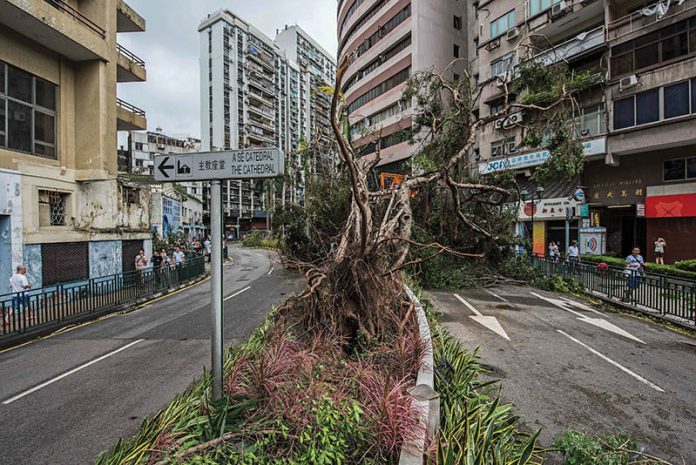Typhoon Hato is one of the 10 International Weather Highlights of 2017. To make the ranking, author Douglas Le Comte (Catastrophic Hurricanes, Asian Monsoon Floods, Near Record Global Warming) considers rarity, size of area affected, costs, duration and socioeconomic impact (fatalities, injuries, power outages, travel disruption, etc.). Hato ticked all the boxes.
 Here are the main facts and figures that stand as a record of this typhoon:
Here are the main facts and figures that stand as a record of this typhoon:
- Caused ten deaths (32 if we count its full passage) – with more than 240 injured
- According to the Expert Group Working Paper on the assessment of damage caused by the typhoon hitting Macau (a Chinese version only exists) Hato is variously described as ‘extreme’, ‘rare’ and ‘serious’
- 29 per cent of the area of Macau was flooded
- It is estimated that the waters rose to 5.5 metres in the Inner Harbour (a record high in Macau since records began in 1925). A maximum storm surge of 2.79 m and a maximum sea level of 6.14 m were recorded at the Zhuhai station.
- The peak gust was 60 mph (in Guangdong Province it reached 150 mph) and the rainfall recorded on 23rd August was 31.0 mm. Hato’s forward speed was the fastest, reaching 32.5 km/h.
- According to the consolidation of data from various sources by the Statistics and Census Service, the economic losses caused by Hato to Macau have been estimated at MOP12.55 billion (direct losses of MOP9.05 billion and indirect losses of MOP 3.50 billion). Global economic losses are estimated at MOP30 billion
- A tropical depression formed over the ocean east of the Philippines in the north-western Pacific during the daytime on 20th August, moving westward to the South China Sea through the Luzon Strait. The tropical depression intensified into a tropical storm at 2:00am on 21st August and was named Hato (1713)

- Hato intensified into a severe tropical storm at 2:00pm on 22nd August and was upgraded to a typhoon at 6:00pm. Hato was within 200km southeast of Macau at 7:00am on 23rd August, maintaining its movement to the west of the Pearl River Delta
- Meanwhile, Hato kept intensifying and reached its peak at noon (central pressure 945hPa, maximum wind speed near centre 165km/hr), causing significant storm surge to coastal areas. Hato made landfall in Zhuhai, Guangdong around 1:00pm, coming closest to Macau at the same time, about 40km west-southwest of the territory. It then kept moving inland west-northwest at 25km/hr before weakening (SMG)
- “In general, typhoons will weaken before making landfall. However, Hato moved quickly and intensified rapidly before making landfall. This phenomenon is rare in history” (SMG). “Hato momentarily attained super typhoon intensity over the sea areas south of Hong Kong, the first time since Hope in 1979 that a tropical cyclone had reached super typhoon intensity during the period when tropical cyclone warning signals No.8 or above were in force in Hong Kong” (Hong Kong Observatory)
- “Electricity and water supplies were also affected. In Guangdong, Guangxi, Fujian, Guizhou and Yannan there were at least 15 deaths, with one missing during the passage of Hato. Around 740,000 people were affected and over 500 houses collapsed, with direct economic loss exceeding RMB27.2 billion” (Hong Kong Observatory)
- Hong Kong weather authorities asked for data revision on Typhoon Hato to be reclassified as a super typhoon (a super typhoon is classified as a tropical cyclone with a maximum 10-minute average wind speed of at least 185km/h)
- Hato formed as a tropical depression over the east of Luzon (Philippines, where it was known as Isang) as at 19th August. The system further developed and became a tropical storm the next day. While weakening, Hato dumped heavy rain and a tornado on Vietnam.
 No more Hato
No more Hato
The Typhoon Committee regularly prepares lists of names for upcoming tropical storms, with input from all participating countries (or regions like Macau or Hong Kong). It is also the task of this Committee to remove names at the request of member countries.
This is what happened this year with a request from China to remove the name of tropical cyclone Hato.
That is, in the next few years (at least) there will not be another Hato.
Japan, which had proposed this name, has already provided alternatives.
Super Hato . . . among others
| 2015 | 2016 | 2017 | |
| Number of tropical cyclones | 3 | 8 | 8 |
| Negative effects (cases) | 57 | 126 | 1,504 |
| Casualties (persons) | – | – | 10 |
| Fallen trees | 24 | 46 | 157 |
| Broken windows or glass | – | – | 127 |
| Floods | 2 | 5 | 88 |
| Maximum gusts (km/h) | – | 79,6 | 217.4 |
| Maximum average wind speed (km/h) | – | 46,8 | 132.0 |
Source: DSEC
























